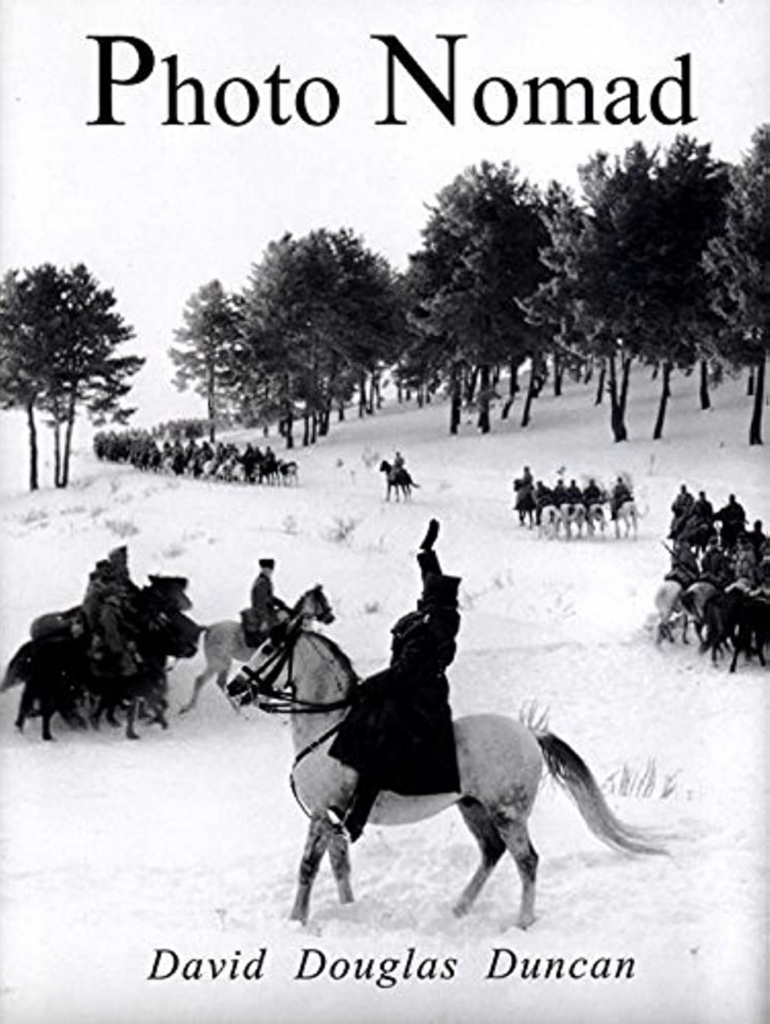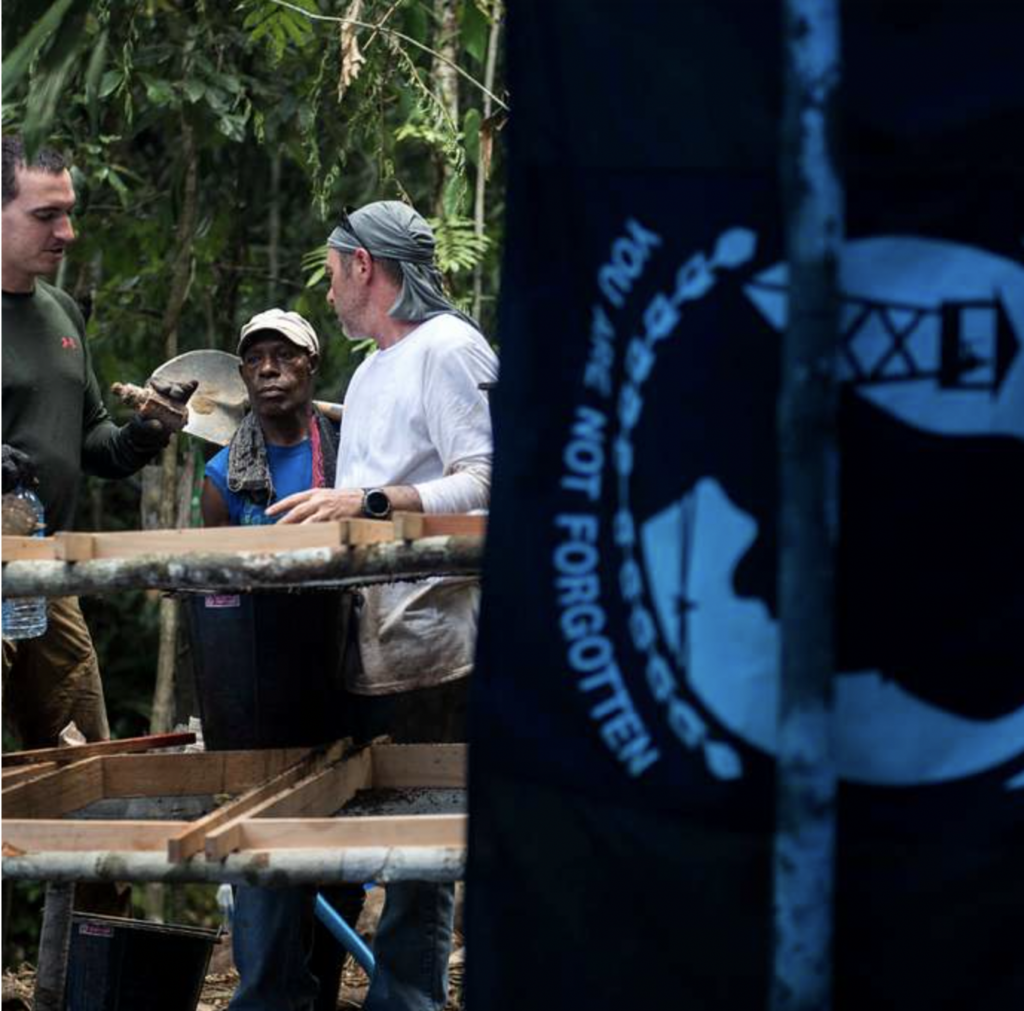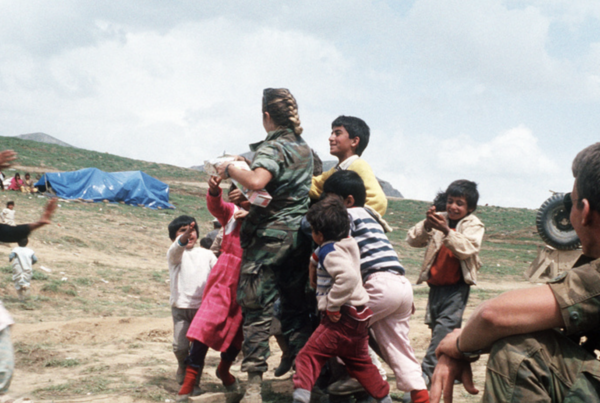
“The most influential photographer of all time.”
-LIFE Magazine
David Douglas Duncan used his vivid, powerful gift to tell war stories– he is famous for his timing and his shocking courage. Duncan once hung out of the empty bomb shaft of a plane in mid-flight to capture a raging World War II battle. One of his very first photos was of a man fighting to get a suitcase from a burning building; the next day Duncan found out that man was ultra-notorious gangster John Dillinger and the suitcase was filled with cash from a bank heist.
Stylistically, his works are each vivid tributes – showing men in the pitch of battle, resigning themselves to what it means to, “have death among them,” as Duncan put it. He works almost exclusively in black and white, in truth.
Duncan’s Americans walk the hallways of history in real-time. In his photos, soldiers are fearless and composed as they liberate the oppressed peoples of the world from Korea to Iraq with the currency of their own blood.

Duncan was wounded in battle several times. The New York Times called him, “A globe-trotting adventurer sometimes likened to Hemingway, he climbed mountains, crossed jungles and was a deep-sea diver, a marine zoologist, a fisherman, an aerial and undersea photographer, an archaeologist in Mexico and Central America and a connoisseur of Japanese art and culture.”
The Great American Novel
If a picture is worth a thousand words, then Duncan has more volumes than any other writer of American History: Much has been said about a desire for The Great American Novel– And perhaps the great David Douglas Duncan’s work is worthy of the title– from his march as a Marine during World War II to the ocean-sands of the Gulf Wars, Duncan’s palladium pen developed his darkroom drafts in silver ink.
WORLD WAR II: He worked as a combat photographer as the US invaded the Pacific, and he was aboard the USS Missouri in 1945 as the Japanese surrendered to Gen. Douglas MacArthur in Tokyo Bay. Later, Duncan introduced the world to the Nikon lens, his recommendation was a boost up for the economy of post-reconstruction Japan at the same time.

THE KOREAN WAR: Later Duncan soliloquized the desperate courage of the Korean War– exposing more than any news article that “Freedom Isn’t Free.”
VIETNAM WAR: And he agitated in the Dark Room of the Vietnam War on behalf of American soldiers.
TRAPPED IN THE SANDS OF THE GOLF WAR: Duncan’s photography flashes light sonnets on the mysteries that enshroud the Gulf War. But it is Duncan’s ability to find the human, even the comical in the midst of the caustic, that sets him apart. For instance, in Photo Nomad, he includes images of Gulf War soldiers golfing in the vast sand traps of the Saudi Desert.
AFGHANISTAN: “A 1955 picture shows Afghan troops in a guard post made of mud, looking across a river that marks the border with the Soviet Union. That photo presaged a Soviet invasion that ultimately came in 1979, unleashing years of war in Afghanistan that still grind on,” according to NPR.
Duncan himself understood the literary quality of his photographic work, “To learn their stories, each page of photographs must be read as carefully as you might read a page of written text in a novel.” This statement preceded his book on the Korean War, “This Is War!” This book has been called the most significant collection of war photographs ever assembled.
“My objective always is to stay as close as possible and shoot the pictures as if through the eyes of the infantryman, the Marine or the pilot,” he told an interviewer in 1951. “I wanted to give the reader something of the visual perspective and feeling of the guy under fire, his apprehensions and sufferings, his tensions and releases, his behavior in the presence of threatening death.”
David Douglas Duncan
With respect and sense Duncan immortalized their sacrifices. In the US we often say, “Remember the Fallen.” David Douglas Duncan canonized them– his War Drum halftones suspend their memory in a bromide of blood and brotherhood.
Only Human: Photo Nomad
However, this Kansas City native’s master collection Photo Nomad doesn’t lead with photos of a flaming gangster or images of himself under battle-fire. Instead, Duncan includes the gentle warmth of the Plaza Lights at Christmas, his dogs, and time with his friend Pablo Picasso.

Duncan plunged into friendships just like war— memorably, with fantastic cheek he entered Pablo Picasso’s home uninvited and took a photo of him in the bath. Thus, he cemented his most famous friendship and found family. “You cannot imagine how simple it was,” Mr. Duncan told Le Monde in 2012. “I was there, like someone belonging to the family, and I took pictures.”
He is humanized by his passion for the charm of his hometown Kansas City, his love for his German Shepherds, and his jaunty, often comical friendship with the quizzical, eccentric Picasso.

Perhaps these inclusions in Photo Nomad are not to be wondered at. It is Duncan’s ability to grasp the human element in the midst of the most inhumane of all times– War– that places him in the hall of great bards and storytellers– A book of photos that is in many ways autobiographical would also unveil the most human parts of himself
Duncan used his ability to humanize the world around him to translate a soldier’s experience to the world. The Guardian reports on the grim fate of soldiers in Korea and Vietnam. “Describing one of his most iconic pictures, a hooded marine vacantly staring into the distance in December 1950, Duncan became emotional even decades later.
“It was dawn. It was very cold, around -30 degrees, we were hungry, we could no longer talk,” he said at a show of his work at the Visa Pour L’Image festival in Perpignan, France, in 2008. “I’m sorry for crying like this …”

Winston Churchill once said, “If you’re in hell, then keep going.” Duncan carried the story of soldiers’ courage through the hell of war and brought them back for the American people and the world to see what their soldiers had done for them.
And that is worth a thousand words.










